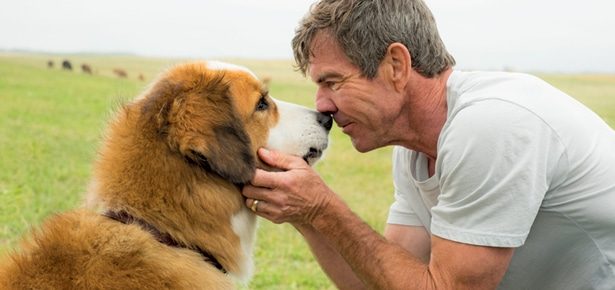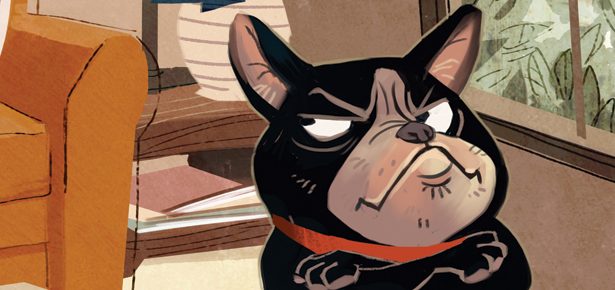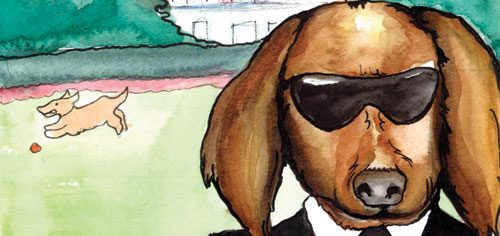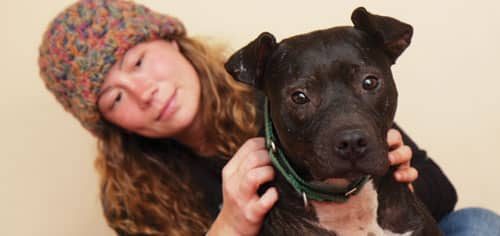
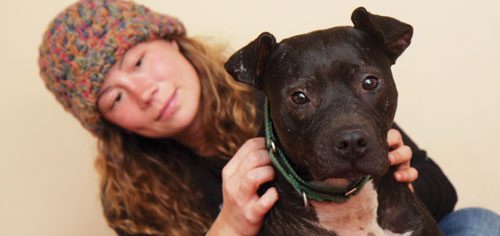
Home at Last
The triumph of Michael Vick’s “Lost Dogs,” a tale of redemption
In a game of association, I’m betting the name Michael
Vick prompts an immediate and visceral reaction. Over
four years after his arrest, Vick continues to be synonymous
with dog fighting, his very mention provoking outrage in
many circles, a testament to the impact of his arraignment and
conviction. Not just sports fans or a nation but people the world
over were horrified as news of the atrocities committed at his
Bad Newz Kennels surfaced. The mutilated corpses of dogs that
refused to fight, the bait dogs, the rape tables, the tortured and
terrified dogs flattened at the back of their cages—the unspeakable
cruelty these animals were subjected to by the formerly celebrated
National Football League (NFL) quarterback dominated
headlines.
So when Jim Gorant, author of The Lost Dogs, a book that
follows the fate of the dogs seized from Vick’s kennels, says that
Michael Vick was the best thing that ever happened to Pit Bulls,
it is, at first, hard to see his logic.
Vick’s dog-fighting operation ran from 2002 until 2007 and
it’s difficult to tally—let alone, read about—the atrocities committed
by Vick and his associates. Luckily, the story we’re
concerned with here is a more cheerful one, the remarkable,
unprecedented tale of the survivors.
Fifty-one dogs were seized in April of 2007, and for a long
time—especially when quantified in dog years—as the case
made its way through the court, the Vick dogs were largely forgotten,
left in kennels without much human contact, assumed
to be too vicious for “normal” lives, and, anyway, they were
evidence in the case. They would, obviously, be put down;
even PETA and the Humane Society did not think they could or
should be saved.
Miraculously, this did not happen.
In a backwards way, it was Vick’s celebrity status that
saved the dogs whose lives he had made a misery. The story
so captured the public’s attention there was an outcry against
these animals suffering one more final injustice at the hands of
humans. It is this story, that of the unlikely rehabilitation and
adoption of these former fighting dogs, that caught the interest
of Gorant.
About a year after Vick pleaded guilty, Gorant, a senior editor
at Sports Illustrated magazine, was having a slow news
week. Looking for inspiration, he turned to Google, hoping to
find a story about the NFL, the magazine’s most popular sport.
Instead, he found a small article about Michael Vick’s dogs
being rehabilitated and put up for adoption.
“I just thought, how does that work?” explains Gorant. “How
the hell do you rehabilitate a fighting dog? What do they mean
by up for adoption? Are they going to be in homes with kids
and with other pets? Where have they been all this time?”
“I pushed it out of my mind,” he remembers, “But it just kept
coming back to me.”
Gorant decided to pitch it internally at the magazine, fully
anticipating the tenuous link to the sports world was too weak.
But everyone at the magazine loved the idea.
In researching the article that would eventually become the
cover story for the December 29, 2008, issue of the magazine,
Gorant would learn a thing or two about Pit Bulls, destroying
his misconceptions about the breed and proving just how loyal,
inspirational, and resilient they can be.
“All I knew was what I read in the headlines…the stereotypes,”
Gorant says. “Now I realize that they’re just dogs, and like any dog, there is potential for good or bad, and a lot of it
depends on how they are socialized and raised.”
The article received more feedback than any other story the
magazine ran in 2008 or 2009, and the majority of it was positive.
Gorant had feared a backlash of anti-Pit Bull stories, or
even questions about whether or not the topic was one that
fit Sports Illustrated’s readership. Instead, his story touched a
chord with the readers. As a result, at the urging of his agent,
Gorant began to expand on the story, to tell more details of the
investigation, the rescue, and the rehabilitation of the 51 dogs
who were seized from Vick’s property.
The resulting book, The Lost Dogs, which was just released
in paperback, reads at times like a mystery novel, detailing the
intricacies of the legal team that worked tirelessly to see Vick
pay for what he had done. It also stands as a passionate portrait
of those involved in the dogs’ rehabilitation. Most importantly,
however, it tells the story of the individual dogs, taking them
from the shadows of the stereotype and proving that, at heart,
they’re just dogs: sometimes silly, sometimes scared, but always
desperate to be man’s best friend.
It was their eventual triumph and these dogs’ remarkable
capacity for forgiveness that significantly changed public perception
of Pit Bulls, and this is the silver lining. Vick’s crime
not only made the horrors of dog fighting front-page news, he
catapulted these abused animals into the forefront of the national
psyche, and showed them to be just that—damaged dogs,
not born killers. He also set a precedent for punishment.
In the landmark sentence, Vick received 23 months in jail
and was ordered to pay $928,000 for the care and treatment of
the dogs found on his property. The surviving 47 Pit Bulls that
had experienced the worst mankind had to offer now had the
chance to prove that a Pit Bull was more than a fighting dog.
This was “ground-breaking,” notes Gorant.
This was “ground-breaking,” notes Gorant.
“Perception-wise, it was the first time that Pit Bulls were
looked at as victims of the crime rather than the gun in a
holdup.”
The case also brought about a change within the legal system,
increasing the number of investigations into dog-fighting
rings and the willingness of police to go after these sorts of
crimes.
Many people still find Vick’s punishment insufficient. Vick’s
prominent return to the NFL spurs ongoing debate over whether
Vick did enough time to pay for the atrocities he committed.
Detractors say he got off too lightly; others defend and praise
him for straightening himself out, for taking his second chance
and running with it. Gorant is more philosophic about it.
“A lot of people fought very hard to ensure that he spent
time in jail, and the original plea agreement recommended 12 to
18 months. He got 23 months. In a way, it’s an insult to those
people and the effort they made and what they put into it to
suggest that he got off too easy, strictly in a legal sense.”
At any rate, that’s not the side of the story that fascinates
Gorant. If there’s a lesson here, it’s from the dogs themselves.
While following their stories as they went from the horrors of
their past life to rescues, fosters, and adoptive homes, learning
how to be ordinary dogs, Gorant learned a few things himself.
He visited shelters and schools, sometimes with one of the
rescued dogs, meeting those inspired by his book, like the teenaged
boys in the Kids in Transition program in New Jersey, a
live-in program for boys with histories of behavioural and emotional
issues resulting from childhood neglect and abuse. The
story of the resilience of the Vick dogs and the way they overcame
adversity resonated strongly with these young men.
“It’s been incredibly unexpected and powerful to see,”
Gorant says. “When you sit down to do this thing, you don’t
think it’ll ever have that sort of impact. You don’t think of it as
something that exists within the world and makes its own way.
In a sense, it becomes beyond you and it does things and goes
places that you never imagined it could. It’s just eye-opening
and shocking and I guess very gratifying.”Which is really it in a nutshell. It has this particular, lasting
resonance because it’s an affecting story about second
chances—both for 47 of Michael Vick’s dogs, which not even
some of the most fervent institutes lobbying for the protection
of animals believed could be saved, and, yes, for Vick himself.
Maybe Donna Reynolds, co-founder of the rescue group Bay
Area Doglovers Responsible About Pitbulls (BAD RAP), said it
best: “Vick showed the worst of us, our blood lust, but this rescue
showed the best.”
Click here to find out where Michael Vick’s dogs are now.
Join the newsletter and never miss out on dog content again!
"*" indicates required fields
By clicking the arrow, you agree to our web Terms of Use and Privacy & Cookie Policy. Easy unsubscribe links are provided in every email.

